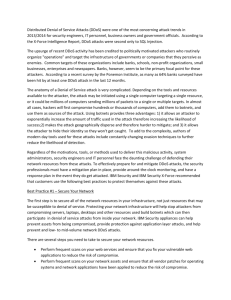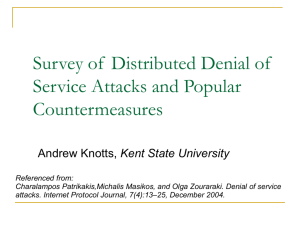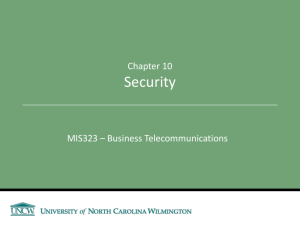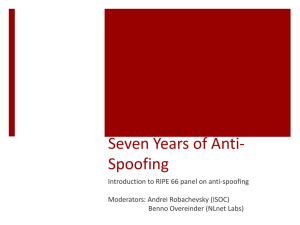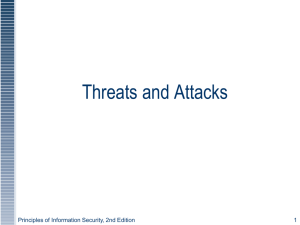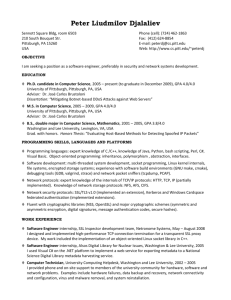Capturing DDoS Attack Dynamics behind the Scenes An Wang , Aziz Mohaisen
advertisement
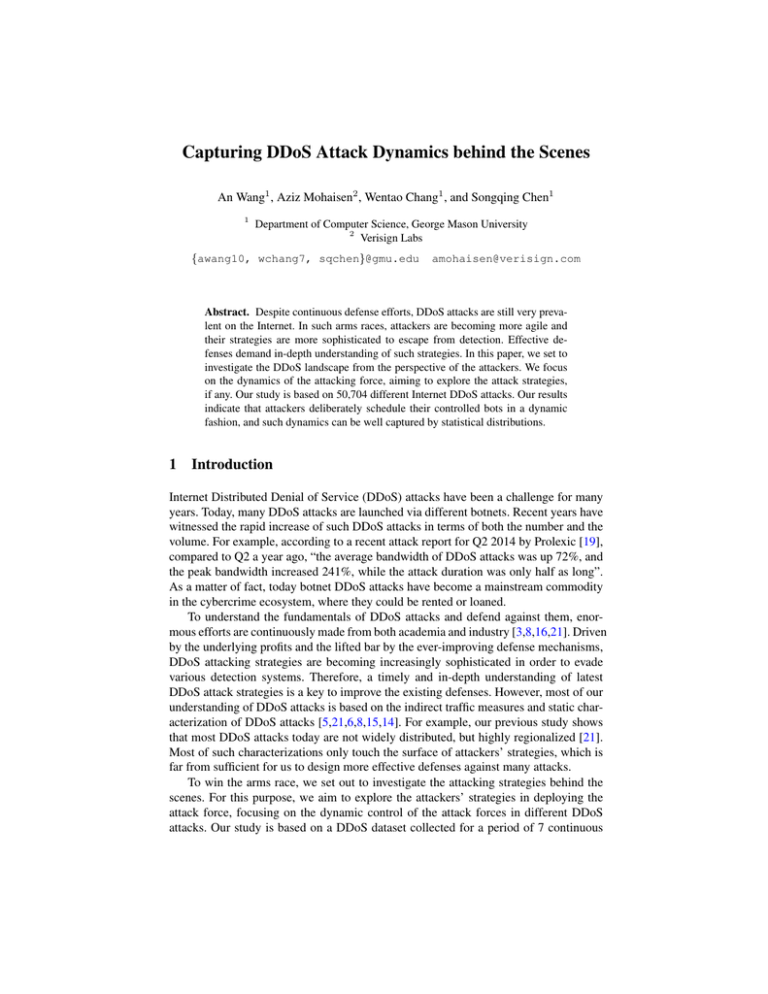
Capturing DDoS Attack Dynamics behind the Scenes
An Wang1 , Aziz Mohaisen2 , Wentao Chang1 , and Songqing Chen1
1
Department of Computer Science, George Mason University
2
Verisign Labs
{awang10, wchang7, sqchen}@gmu.edu
amohaisen@verisign.com
Abstract. Despite continuous defense efforts, DDoS attacks are still very prevalent on the Internet. In such arms races, attackers are becoming more agile and
their strategies are more sophisticated to escape from detection. Effective defenses demand in-depth understanding of such strategies. In this paper, we set to
investigate the DDoS landscape from the perspective of the attackers. We focus
on the dynamics of the attacking force, aiming to explore the attack strategies,
if any. Our study is based on 50,704 different Internet DDoS attacks. Our results
indicate that attackers deliberately schedule their controlled bots in a dynamic
fashion, and such dynamics can be well captured by statistical distributions.
1
Introduction
Internet Distributed Denial of Service (DDoS) attacks have been a challenge for many
years. Today, many DDoS attacks are launched via different botnets. Recent years have
witnessed the rapid increase of such DDoS attacks in terms of both the number and the
volume. For example, according to a recent attack report for Q2 2014 by Prolexic [19],
compared to Q2 a year ago, “the average bandwidth of DDoS attacks was up 72%, and
the peak bandwidth increased 241%, while the attack duration was only half as long”.
As a matter of fact, today botnet DDoS attacks have become a mainstream commodity
in the cybercrime ecosystem, where they could be rented or loaned.
To understand the fundamentals of DDoS attacks and defend against them, enormous efforts are continuously made from both academia and industry [3,8,16,21]. Driven
by the underlying profits and the lifted bar by the ever-improving defense mechanisms,
DDoS attacking strategies are becoming increasingly sophisticated in order to evade
various detection systems. Therefore, a timely and in-depth understanding of latest
DDoS attack strategies is a key to improve the existing defenses. However, most of our
understanding of DDoS attacks is based on the indirect traffic measures and static characterization of DDoS attacks [5,21,6,8,15,14]. For example, our previous study shows
that most DDoS attacks today are not widely distributed, but highly regionalized [21].
Most of such characterizations only touch the surface of attackers’ strategies, which is
far from sufficient for us to design more effective defenses against many attacks.
To win the arms race, we set out to investigate the attacking strategies behind the
scenes. For this purpose, we aim to explore the attackers’ strategies in deploying the
attack force, focusing on the dynamic control of the attack forces in different DDoS
attacks. Our study is based on a DDoS dataset collected for a period of 7 continuous
2
months. Our dataset was provided by Team Cymru and is collected using passive and
active techniques from multiple anchor points. The data was collected from August 28,
2012 to March 24, 2013, a total of 209 days (about seven months of valid and marked
attack logs). In this seven-month period, a total of 50,704 different DDoS attacks were
observed—more details are in [4]. Through our analysis, we find several interesting results. We find that a botnet family often uses a limited number of sophisticated patterns
in dynamically scheduling bots to participate in various DDoS attacks. This dynamic
scheduling is indicated by the shifting patterns of participating bots. Further, the bot
shifting pattern in different botnet families can be well captured by statistical distributions, with parameters depending on the corresponding family.
The preliminary findings in this study not only refresh our understanding of today’s
Internet DDoS attacks, but also offer new insights for security analysts to identify botnet
families and help predict how the attacking forces evolve over time during attacks.
The rest of the paper is organized as follows. In Section 2, we describe our dataset
including the overall data statistics and the data fields we utilized for our analysis. In
Section 3, we study the bot shifting pattern of each botnet family, the basic characteristics of each pattern We discuss related work in Section 4 and conclude with a concise
summary of our analyses and their implications in Section 5.
2
Dataset Collection
The dataset is based on Team Cymru’s constant monitoring of Internet critical infrastructure to aid intelligence gathering concerning the state of the art of attack posture,
using both active and passive measurement techniques.
Even though there might be some potential skews in our dataset, our preliminary
studies [21,5,4] suggest that our dataset still preserves the geographical features of
botnet families. The unit constantly monitors Internet attacking traffic to aid the mitigation efforts of its customers, using both active and passive measurement techniques.
For active measurements and attribution, malware families used in launching the various attacks are reverse engineered, and labeled to a known malware family using best
practices. A honeypot is then created to emulate the operation of the reverse-engineered
malware sample and to enumerate all bots across the globe participating in the particular botnet. A similar approach has been proposed by Kang et al. [9] As each botnet
evolves over time, new generations are marked by their unique hashes.
Traces of traffic associated with various DDoS campaigns are then collected at various anchor points across the globe in cooperation with various ISPs. The traces are
then analyzed to attribute and characterize attacks on various targets. The collection of
traffic is guided by two general principles: 1) that the source of the traffic is an infected
host participating in a DDoS campaign, and 2) the destination of the traffic is a targeted
client, as concluded from eavesdropping on C&C of the campaign using a live sample,
or where the end-host is a customer of the said DDoS mitigation company.
The analysis is high level in nature to cope with the high volume of ingest traffic
at peak attack times—as shown later, on average there were 243 simultaneous verified
DDoS attacks launched by the different botnets studied in this work. High level statistics
associated with the various botnets and DDoS attacks are recorded every one hour. The
3
Table 1. Summary of the workload information
Summary of Attackers
Summary of Victims
description
count
description
count
# of bot ips
310950
# of target ip 9026
# of cities
2897
# of cities
616
# of countries
186
# of countries
84
# of organizations 3498 # of organizations 1074
# of asn
3973
# of asn
1260
workload we obtained ranges from August 28, 2012 to March 24, 2013, a total of 209
days (about seven months of valid and marked attack logs). In the log, a DDoS attack
is labeled with a unique DDoS identifier, corresponding to an attack by given DDoS
malware family on a given target. We cannot reveal the capability of the capturing
facility because attackers would learn such information, which is also critical to the
business of the data source.
Table 1 sums up some statistics of our dataset, including information from both the
attacker and the target sides. Over a period of 28 weeks, 50,704 different DDoS attacks
were observed. These attacks are launched by 674 different botnets. These attacks targeted victims located in 84 different countries, 616 cities, involving 1074 organizations,
residing in 1260 different autonomous systems. In our analysis, we focus on the botnets involved in DDoS attacks. However, [4] contains more detailed information about
botnet family activities and patterns.
The attackers’ IP information enables us to study the geolocation distribution of
each botnet family. Contrary to the traditional understanding of DDoS attacks, the attacks are not very distributed but rather highly regionalized [21]. Each family has its
own geolocation preferences. Among all the families, Dirjumper covers the largest
number of countries: 164. A comparable coverage is Optima’s: 153. Even though these
families have very broad country coverages, the average number of bots participating
in each attack pertaining to those botnets is small.
3
Attack Dynamics
To seek an in-depth understanding of attackers’ strategies, we set to explore attacks
from the adversary’s perspective. By doing that, we are motivated to find out how their
controlled bots are scheduled to participate in attacks. To this end, we use the IP information of the bots captured in our dataset. Our analysis starts off from two different
perspectives, namely the bot shift pattern dynamics and the multi-owned bot attacking
interval, both of which are related to DDoS attack strategies.
For any DDoS attack, it evolves over time in terms of the attacking force. In our
dataset, each entry represents a snapshot of the DDoS attacks captured at that time point.
As a result, each DDoS can be represented by a chronological sequence of snapshots.
Dynamic characterizations can be captured by analyzing each data record.
For each entry in our dataset, we have the IP information of all the bots participating in that DDoS attack at that moment, of which the country code (cc) could also be
4
obtained from such information (the snapshots are updated hourly). Thus, the dataset
contains all the IP information of bots involved. After further organizing the bots based
on their country code, each entry in the dataset can be denoted by < cc1 : n1 , cc2 :
n2 , . . . , ccm : nm > where each cci , i ∈ [1 . . . m] represents the country code where
the bots locate; while for each ni , i ∈ [1 . . . m] denotes the number of bots located in
cci , i ∈ [1 . . . m]. Since each of such vector represents a snapshot, so if we line up all
the vectors belonging to the same DDoS attack together, we can observe the deployment differences by comparing the number of bots in each country and the number of
countries involved. For example, if we have two such records, denoted by vec1 and
vec2 , the change can be denoted by vec2 − vec1 =< cc1 : ∆1 , cc2 : ∆2 , . . . , ccj :
∆j >= vec∆v . Notice that the lengths of vec1 and vec2 may not be equal and the
length of vec∆v will be the same as the longer one. Thus, the difference vector reflects
the changes of the bots numbers at the country level for the the given attack, which is
defined as shift in our analysis.
To further quantify such changes, we use the notion of shift expectation to represent
each attacking force shift. In another word, each vector described above will be denoted
by a single value called shift expectation, whose calculation will be elaborated later.
In this way, each DDoS attack can be denoted by a vector whose elements are shift
expectation, i.e. < Eshif t1 , Eshif t2 , . . . , Eshif tm >, since each DDoS attack can be
denoted by a time series of snapshots. And the length of this vector is determined by
both the number of magnitude changes happened in each attack as well as the number
of snapshots taken for each attack.
m
X
The shift expectation is calculated as
pi × ∆i , where ∆i is obtained from vec∆v
i=1
and pi denotes the probability estimator of the shift. And pi is computed as follows.
From our dataset, we obtain the geolocation information of all bots involved in the
DDoS attacks. For each family, we generate a table that has two columns; the first
column contains all the country codes that are covered by this family while the second
one has the corresponding number of bots that locate in that country. So each entry in
this table is denoted by (cci , ni ), for i ∈ [1 . . . l]. On the other hand, pi , i ∈ [1 . . . l], is
ni
. With both pi and ∆i , the expectation of each shift Eshif t can
calculated as Pl
j=1 nj
be calculated. After converting each DDoS attack into a time series vector, we have all
the vectors with various lengths for all the DDoS attacks in our dataset. Our following
analyses will be built on top of these vectors.
3.1
Bots shift pattern analysis
First, we use the K-means clustering on all attack vectors of each family. Since the
lengths of vectors may vary, we cannot calculate the Euclidean distance between vectors
directly. The Dynamic Time Warping (DTW) has been widely used for shape matching
and time series classification. Accordingly, we use DTW to calculate the distance and
similarity between attack vectors. To reduce the distortion under the influence of attack
magnitude, we normalize the vector before we calculate the DTW distance on them.
The results are shown in Figure 1 - Figure 4. In these figures, x-axis represents
Shift Times, which is determined by the number of snapshots belonging to each DDoS
0.45
0.8
0.4
0.7
0.35
0.6
Shift Expectation
Shift Expectation
5
0.3
0.25
0.2
0.15
0.1
0.05
00
20
40
60
80
Shift Times
100
120
1400
5
10
15
20
25
30
35
40
45
50
0.5
0.4
0.3
0.2
25
0.1
00
Attack ID
20
15
50 100
150 200
250 300
350 400
Shift Times
450 5000
10
Attack ID
5
0.7
0.7
0.6
0.6
0.5
0.5
Shift Expectation
Shift Expectation
Fig. 1. Dirtjumper: attacks with same bot shift Fig. 2. Dirtjumper: attacks with similar bot shift
pattern
pattern
0.4
0.3
0.2
80
0.1
70
0.4
0.3
0.2
0.1
60
00
50
20
00
40
40
60
Shift Times
30
80
100
20
120
10
1400
Attack ID
20
40
60
Shift Times
80
100
120
140
1600
2
4
6
8
10
12
14
16
18
Attack ID
Fig. 3. Pandora: attacks with same bot shift pat- Fig. 4. Pandora: attacks with similar bot shift
tern
pattern
attack; y-axis represents Attack ID, which is used to differentiate different DDoS attacks; z-axis represents the calculated Shift Expectation values. Figure 1 and Figure 2
illustrate two of the four largest clusters discovered by the K-means algorithm of the
Dirtjumper family, where K = 10. We cluster these vectors into 5, 10, and 20 clusters.
It is shown that clustering them into 10 clusters yields better results. So, we present the
two largest clusters of the 10 clusters for brevity. The two clusters contain 54 and 24
attacks, respectively. In each figure, the x-axis represents the length of the attack vector,
i.e., the shifts happened in a single attack; the y-axis represents the unique DDoS ID;
and the z-axis represents the shift expectation of each shift. Note that since Dirtjumper
has too many DDoS attacks with different lengths of shifts, we first group the attacks
by size. In this study, we focus on the analysis of attack vectors that have more than 100
shifts, which include 242 attacks launched by Dirtjumper. Our following analyses are
based on this subset of our dataset as well.
In these figures, the expectations should be discrete values. To more clearly show
the changes, we use lines to connect these dots. Figure 1 shows that in these attacks,
bots are being scheduled with the exact same pattern in different attacks, while Figure 2
indicates a similar pattern—although not identically—in different attacks. With further
inspection, we find that in Figure 1 there are 46 simultaneous DDoS attacks ongoing to-
6
1
0.9
0.8
0.7
cluster_10
cluster_1
cluster_2
cluster_3
cluster_4
cluster_5
cluster_6
cluster_7
cluster_8
cluster_9
CDF
0.6
0.5
0.4
0.3
0.2
0.1
0
0
0.02
0.04
0.06
0.08
0.1
0.12
0.14
Normalized Distance to Cluster Centroids
Fig. 5. Vector Distances CDF
wards the same target located in Finland, which is a company providing communication
services from basic broadband to high-speed fiber connections.
These results suggest that the attacking forces are not randomly scheduled by the
attackers in Dirtjumper. Also, simultaneous attacks cannot be arranged by a completely
random deployment strategy. There has to be certain strategies behind DDoS attacks
launched by each family. To see if such a pattern is specific to Dirtjumper or generalizable to others, we examine other families. Figure 3 and Figure 4 illustrate two clusters
of another active botnet family Pandora. We use the same K-means clustering with 10
clusters for attacks and more than 100 shifts as before. We have similar observations
on Pandora as on Dirtjumper. While other families show similar results, we omit them
due to page limit. These findings also suggest that there might be a way to detect DDoS
attacks based on these shift behaviors. But this only will be possible if we can precisely
model these pattern, which is the aim of our next step.
3.2
Mathematical representation of shift patterns
To further explore the pattern behind these vectors, we first find the centroid vector of
each cluster and then calculate the distance between each attack vector in that cluster
and the centroid. The centroid vector cannot be calculated simply by averaging all the
vectors involved since they are of different length. We define centroid vector as the
vector that has the smallest total distance to all other vectors. And all the distances
involved are measured by DTW distance. We use Dirtjumper as an example since it is
the most active family.
The CDF of the distance distribution for Dirtjumper is shown in Figure 5. In this
figure, each curve represents a cluster. If we observe these curves, the distances seem to
follow the normal distribution very well except for cluster-1. To verify the distribution,
we further fit the data into multiple distributions, including tlocationscale distribution,
7
Probability Density Function
60
empirical
tlocationscale
logistic
normal
extreme value
Probability Density
50
40
30
20
10
0
-0.02
0
0.02
0.04
0.06
0.08
0.1
0.12
0.14
Normalized Distance to Cluster Centroids
Fig. 6. Distribution Fit
normal distribution, logistic distribution and extreme value distribution. The fitting results are shown in Figure 6.
Except for the extreme value distribution, all other distribution functions are symmetric distributions. Figure 6 shows that the data fit the tlocationscale distribution best.
tlocationscale distribution is the generalized Student’s t-distribution into location-scale
family. Location-scale family is a family of univariate probability distributions parameterized by a location parameter and a non-negative scale parameter. The tlocationscale
distribution is useful for modeling data distribution with heavier tails than the normal
distribution, meaning that it is more prone to producing values that fall far from its
mean. This makes it useful for understanding the statistical behavior of certain types
of ratios of random quantities. In this case, the distribution describes the distances between multiple shift patterns of botnets. It means that if we use the centroids of different
clusters as a baseline, we can learn and predict how the bots are going to shift based on
this distribution.
To this end, it is likely that attackers are utilizing this feature to arrange and control
bots during attacks, especially with a large number of bots. From a defense perspective,
such information can be very useful. On one hand, with this information—even though
there might be more than one shift pattern per family—we can predict how attacks shift
based on the distribution. On the other hand, we can simulate DDoS attacks behaviors,
not only based on traffic volume but also by incorporating dynamics behind them.
Similar to Figure 5, we also plotted a CDF for Pandora’s clusters, which confirmed
the similar behavioral patterns. However, compared to Dirtjumper, Pandora exhibits
a slight deviation in the distribution, perhaps due to the smaller number of attacks in
Pandora compared to Dirtjumper. Results obtained by analyzing other families reveal
similar findings.
Besides the pattern clustering graphs, Table 2 summarizes some statistical information about Pandora clusters. In this table, Size shows the size of each cluster; Max Diss
8
Table 2. Statistic Information of Pandora Cluster
Size Max Diss Avg Diss Diameter Separation Avg Exp Max Exp
97
3.69
0.18
3.73
3.46
0.03
0.74
74
0.06
0.02
0.09
3.62
0.03
0.63
20
4.52
1.46
4.99
2.39
0.025
0.88
17
3.48
0.41
3.48
2.39
0.028
0.68
7
4.18
1.06
4.30
3.57
0.03
0.88
Std
0.076
0.08
0.073
0.075
0.08
represents the maximum distance between any two vectors in the same cluster; Diameter represents the largest dissimilarity between any two pairs of the observations within
the same cluster; Separation represents the minimal dissimilarity between an observation of the cluster and an observation of another cluster; Avg Exp shows the average
shift expectation of each cluster and Std is the standard deviation of expectations of each
cluster. Statistically speaking, the smaller the Diameter, the better the cluster. From this
table, we can see that the second cluster is the best, which also conforms with Figure 3.
Another observation from this table is that for most clusters, the Diameter is larger
than Separation, meaning that these clusters are not totally isolated. The total isolation
means that the patterns might be attack-specific. However, results show the opposite:
each cluster still shares some similarities with other clusters. This further indicates that
there might be certain dynamic mechanisms behind each family.
4
Related Work
DDoS attacks have been intensively investigated and numerous measurement works
have been done to help achieve better understanding of them. In 2006, Mao et al. [16]
presented their measurement work of DDoS attacks relying on both direct measurement
of flow-level information and more traditional indirect measurements using backscatter analysis. Moore et al. [17] conducted a backscatter analysis for quantitatively estimating DoS activity in the Internet based on a three-week dataset. Due to the growth
of network address translation and firewall techniques, much of the Internet was precluded from the study by the traditional network measurement techniques. Thus, in the
early days, the work [3] proposed an opportunistic measurement approach that leverages sources of spurious traffic, such as worms and DDoS backscatter, to unveil unseen
portion of Internet. In 2010, a more recent study [23] revisited the same topic and characterized the current state of background radiation specifically highlighting those which
exhibit significant differences. Our work serves as a revisit to those studies with new
insights. Bailey et al. [1] designed and implemented the Internet Motion Sensors (IMS),
a globally scoped Internet monitoring system to detect Internet threats, which includes
a distributed blackhole network with a lightweight responder and a novel payload signature and caching mechanism. Xu et al. [24] presented a general methodology to build
behavior profiles of Internet backbone traffic in terms of communication patterns of
end-hosts and services.
In our work, we focus on DDoS dynamics. We use several techniques including
K-means clustering and Dynamic Time Warping (DTW). DTW was first introduced in
9
the data mining community in the context of mining time series proposed by Berndt et
al. [7]. Several techniques have been introduced to speed up DTW and to reduce the
space overhead [12,11]. The K-means clustering methods we use were first proposed
by Lloyd et al. [18]. And it remains a very popular method of clustering after many
years perhaps due to the simplicity of the algorithm and its effectiveness in practice.
These techniques successfully helped us discover the principles of the dynamics behind
the scenes. Several other works focused on DDoS dynamics analysis as well, including
Arne et al. [22], Armin et al. [2], Mohammad et al. [10], Kührer et al. [13]. In Stringhini
et al. [20], a similar approach was proposed to model the country distribution of bots
and cluster together botnets.
5
Conclusion
DDoS attacks remain one of the most challenging threats on the Internet, despite numerous efforts to characterize, model, and defend against them. This indicates that increasingly sophisticated strategies are being employed by the DDoS attackers. Successful
defenses demand in-depth understanding of their strategies. In this work, we have conducted a preliminary analysis on a large scale DDoS dataset, aiming to understand the
dynamics of the DDoS attack strategies behind the scenes. With the help of Dynamic
Time Warping and clustering, we have found that attackers are deliberately and dynamically deploying their attack forces in individual or collaborative attacks, indicating
the strong bond and organization of different botnet families in various attacks. Furthermore, such dynamics can be well captured by statistical distributions. These results
add to the existing literature of DDoS characterization and understanding. More importantly, they lay a promising foundation for us to predict the dynamics during a DDoS
attack in the future, which could be utilized to enhance existing defenses.
6
Acknowledgment
This work is partially supported by National Science Foundation (NSF) under grant
CNS-1117300. The views and opinions expressed in this paper are the views of the
authors, and do not necessarily represent the policy or position of NSF or VeriSign,
Inc.
References
1. Bailey, M., Cooke, E., Jahanian, F., Nazario, J., Watson, D., et al.: The internet motion sensora distributed blackhole monitoring system. In: NDSS (2005)
2. Büscher, A., Holz, T.: Tracking ddos attacks: Insights into the business of disrupting the
web. In: Proceedings of the 5th USENIX Workshop on Large-Scale Exploits and Emergent
Threats (LEET), San Jose, CA, USA (2012)
3. Casado, M., Garfinkel, T., Cui, W., Paxson, V., Savage, S.: Opportunistic measurement: Extracting insight from spurious traffic. In: Proc. 4th ACM Workshop on Hot Topics in Networks (Hotnets-IV) (2005)
10
4. Chang, W., Mohaisen, A., Wang, A., Chen, S.: Measuring botnets in the wild: Some new
trends. In: ACM ASIACCS (2015)
5. Chang, W., Wang, A., Mohaisen, A., Chen, S.: Characterizing botnets-as-a-service. In: Proceedings of the ACM SIGCOMM (poster) (2014)
6. Feinstein, L., Schnackenberg, D., Balupari, R., Kindred, D.: Statistical approaches to DDoS
attack detection and response. In: DARPA Information Survivability Conference and Exposition (2003)
7. J.Berndt, D., Clifford, J.: Using dynamic time warping to find patterns in time series. In:
KDD workshop (1994)
8. Jin, S., Yeung, D.: A covariance analysis model for ddos attack detection. IEEE International
Conference on Communications (2004)
9. Kang, B.B., Chan-Tin, E., Lee, C.P., Tyra, J., Kang, H.J., Nunnery, C., Wadler, Z., Sinclair,
G., Hopper, N., Dagon, D., et al.: Towards complete node enumeration in a peer-to-peer
botnet. In: Proceedings of the 4th International Symposium on Information, Computer, and
Communications Security. pp. 23–34. ACM (2009)
10. Karami, M., McCoy, D.: Understanding the emerging threat of ddos-as-a-service. In: LEET
(2013)
11. Keogh, E., Ratanamahatana, C.A.: Exact indexing of dynamic time warping. In: Knowledge
and Information Systems (2005)
12. Kim, S.W., Park, S., W.Chu, W.: An index-based approach for similarity search supporting
time warping in large sequence databases. In: Proceedings of International Conference on
Data Engineering (2001)
13. Kührer, M., Hupperich, T., Rossow, C., Holz, T.: Exit from hell? reducing the impact of
amplification ddos attacks. In: USENIX Security Symposium (2014)
14. Lee, K., Kim, J., Kwon, K.H., Han, Y., Kim, S.: DDoS attack detection method using cluster
analysis. Expert Systems with Applications 34, 1659–1665 (2008)
15. Li, M.: Change trend of averaged hurst parameter of traffic under ddos flood attacks. Computers and Security (2006)
16. Mao, Z.M., Sekar, V., Spatscheck, O., van der Merwe, J., Vasudevan, R.: Analyzing Large
DDoS Attacks using Multiple Data Sources. In Proceedings of ACM SIGCOMM Workshop
on Large-Scale Attack Defense (2006)
17. Moore, D., Shannon, C., Brown, D.J., Voelker, G.M., Savage, S.: Inferring internet denialof-service activity. ACM Transactions on Computer Systems (TOCS) 24(2), 115–139 (2006)
18. P.Lloyd, S.: Least squares quantization in pcm. In: IEEE Transactions on Information Theory
(1982)
19. Prolexic:
Q2
2014:
Malicious
actors
switch
tactics
to
build,
deploy
and
conceal
powerful
botnets.
http://www.prolexic.com/
knowledge-center-ddos-attack-report-2014-q2.html (June 2014)
20. Stringhini, G., Holz, T., Stone-Gross, B., Kruegel, C., Vigna, G.: BOTMAGNIFIER: Locating Spambots on the Internet. In: USENIX Security Symposium (2011)
21. Wang, A., Chang, W., Mohaisen, A., Chen, S.: How distributed are today’s ddos attacks? In:
Proceedings of the ACM CCS (poster) (2014)
22. Welzel, A., Rossow, C., Bos, H.: On measuring the impact of ddos botnets. In: Proceedings
of the Seventh European Workshop on System Security. p. 3. ACM (2014)
23. Wustrow, E., Karir, M., Bailey, M., Jahanian, F., Huston, G.: Internet background radiation
revisited. In: Proceedings of the 10th ACM SIGCOMM conference on Internet measurement.
pp. 62–74. ACM (2010)
24. Xu, K., Zhang, Z.L., Bhattacharyya, S.: Profiling internet backbone traffic: behavior models
and applications. In: ACM SIGCOMM Computer Communication Review. vol. 35, pp. 169–
180. ACM (2005)

